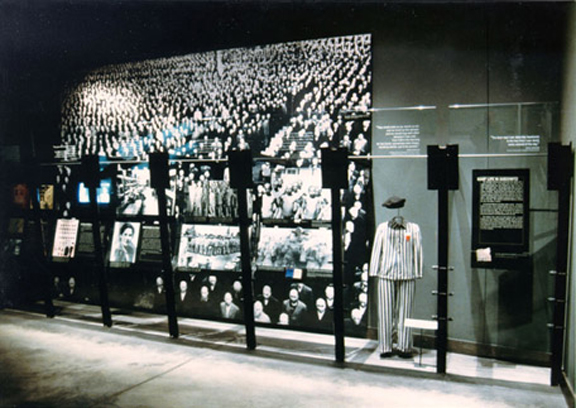
As I round the corner and come to the third hall, the ceiling seems to be caving down around me and I begin to feel claustrophobic. I'm greeted by a large display reading, "Lost Humanity: Life and Death in the Nazi camps". As the amount of ambient light seems to have decreased, so the content has become even darker. The hall starts with a quotation by a Houston survivor of seven camps who said, "Our destination was extermination". From below, a glass display case protrudes from the sign and contains a child's shoe from one of the concentration camps. I can see the decaying and smashed leather, the cracks and the mud, and feel as though I just pulled the shoe out of the dirt myself. Spanning the entire hall, in the center of the room a large display is made up of wooden framed glass suspended from the ceiling and floors.
The first frame houses a small suitcase which held all of a jewish woman's belongings while she was in the camp. Photos and descriptions abound of the arrival to the camps and the selection process. In the center display the next frame houses pictures of piles of hair, glasses, suitcases, clothes, and gold teeth. Below, a small glass display case protrudes with fragments of glasses found at Auschwitz. Another Houston survivor is quoted saying, "There were mountains of clothes from the people they burned. Our job was to sort out all the shoes, glasses, gold teeth, moneyÉ and then they sent them to Germany". The rest of the center display features photos of the processing, with pictures of naked men having their heads shaved and given striped uniforms. Next to it the first color photo of the exhibit features an aged man's arm with a number tattooed into it.
On the opposite wall, a large map in German shows the hundreds of concentration camps and prisons. On the map, red dots show places where Houston survivors were imprisoned. Right next to it, a display lists the camps where Houston survivors stayed and contains more than 100 names. Perpendicular to that wall and the center display, another glass display sits about 6 feet high and leans in toward the viewer. On the upper section of each pane a quotation is written in white. Behind the glass are more objects and images from the camps. The first section contains another glass display case behind it with a full striped uniform from one of the camps. Behind other parts of the display I find a brick from a concentration camp's crematorium and an opened can of Zyklon B Gas, the poison used in the gas chambers. I shudder at the thought of how many people the one can killed.

Behind this large glass display which leans toward the visitor, a large photograph takes up almost the entire wall with an image of thousands of newly arrived, freshly shaved prisoners standing with no room to move. As I turn and find myself on the opposite side of the center display, I find an unusual technology of display. In the wall itself, it seems as if two long rows have been cut. From straight on, all I can see from the rows is a glowing light. However, on approaching, I notice that the rows are cut diagonally into wall and then looking down from above into the row, I meet the most shocking images I've seen yet. The display is titled "Mass Murder".
Inside, the pictures are small and viewers are encouraged to lean in toward to rows to take in a close view of each picture individually. Images contained in the photos include children whose bodies had been severely burnt in an "experiment", pictures of piles of corpses, close up shots of dead faces, pictures of starving and naked men lined up, thin as twigs and completely shaven. Another photo shows a young woman being forced into a gas chamber, a picture taken secretly by a Polish prisoner. Perhaps the most shocking image was one of four young boys who had had their sex organs removed in an "experiment" by Dr. Josef Mengele. This display, like the angled pictures, is somewhat more interactive than normal photos, as the viewer must reposition their body to view each of the two rows. Similarly, children would have a hard time viewing the images since you need to be a certain height to be able to look down into the rows. However on the same token, on my most recent visit I experienced this display next to a woman in a wheelchair who undoubtedly had a different experience than I did since she was unable to see the top row of pictures. At the end of the bleak and depressing hall sits a small video monitor showing constantly rotating photos of children who died in the Holocaust, all members of Houston families.